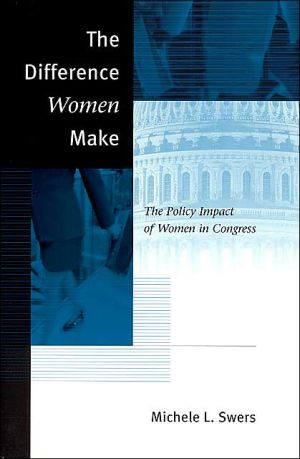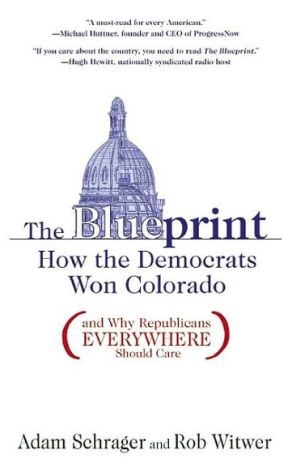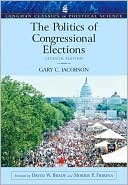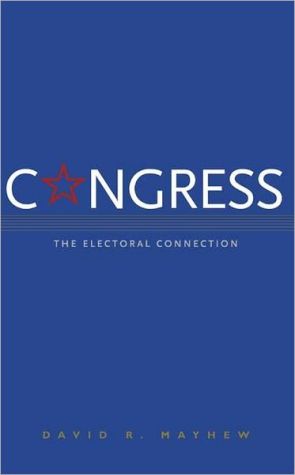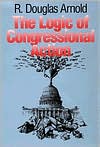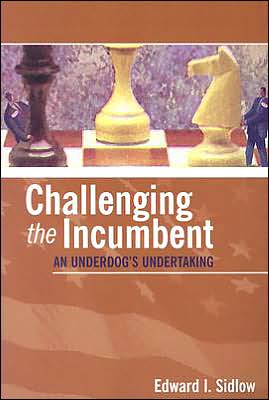The Difference Women Make: The Policy Impact of Women in Congress
What if there were more women in Congress? Providing the first comprehensive study of the policy activity of male and female legislators at the federal level, Michele L. Swers persuasively demonstrates that, even though representatives often vote a party line, their gender is politically significant and does indeed influence policy making.\ Swers combines quantitative analyses of bills with interviews with legislators and their staff to compare legislative activity on women's issues by male...
Search in google:
What if there were more women in Congress? Providing the first comprehensive study of the policy activity of male and female legislators at the federal level, Michele L. Swers persuasively demonstrates that, even though representatives often vote a party line, their gender is politically significant and does indeed influence policy making.Swers combines quantitative analyses of bills with interviews with legislators and their staff to compare legislative activity on women's issues by male and female members of the House of Representatives during the 103rd (1993-94) and 104th (1995-96) Congresses. Tracking representatives' commitment to women's issues throughout the legislative process, from the introduction of bills through committee consideration to final floor votes, Swers examines how the prevailing political context and members' positions within Congress affect whether and how aggressively they pursue women's issues.Anyone studying congressional behavior, the role of women, or the representation of social identities in Congress will benefit from Swers's balanced and nuanced analysis.
The Difference Women Make: the Policy Impact of Women in Congress\ \ By Michele L. Swers \ University of Chicago Press\ Copyright © 2002 Michele L. Swers\ All right reserved.\ ISBN: 0226786498 \ \ \ Chapter 1 - Does Electing Women Have a Policy Impact? \ \ On October 20, 1999, a group of largely Democratic women took to the floor of the House of Representatives to support an amendment by Congresswoman Patsy Mink (D-HI) that would restore funding for gender equity programs to a Republican bill reauthorizing parts of the 1965 Elementary and Secondary Schools Education Act. As evidence of the continuing need for gender equity programs, Congresswoman Stephanie Tubbs Jones (D-OH) cited women's underrepresentation in Congress. She proclaimed, "Women need to be encouraged to be right here on the floor ... they need to think about how can we be here on the floor of the U.S. Congress talking about issues that impact the entire country and only fifty-seven of us are women" (Congressional Record 1999, October 20, H10502).\ \ Congresswoman Tubbs Jones's comments imply that electing more women to Congress will not just achieve equality but also influence the range of issues considered on the national agenda and the formulation of policy solutions. She is not alone in her belief that electing more women will have a substantive policy impact. Numerous women's Political Action Committees (PACs) raise money to elect liberal orconservative women candidates. For example, the Women in Senate and House (WISH) List raises money for pro-choice Republican women, while the Susan B. Anthony List supports pro-life women (Nelson 1994). In the 2000 election cycle, Early Money Is Like Yeast's (EMILY's) List raised $21,201,339 to support pro-choice, Democratic women, thus making it one of the leading fundraisers among all PACs (Federal Election Commission 2001a, 2001b). Some women candidates even point to their gender as one of the reasons voters should elect them. Announcing her candidacy for the Senate in 1998, Blanche Lambert Lincoln (D-AR) proclaimed that she was running because "nearly one of every three senators is a millionaire, but there are only five mothers" (Greenblatt 1997). Similarly, Patty Murray (D-WA) launched her 1992 Senate campaign as "just a mom in tennis shoes" (Schroedel and Snyder 1994). \ \ Paradoxically, though the level of attention to the potential policy impact of women has increased, one of the more well-established tenets of congressional research asserts that the personal identity of the member is largely irrelevant to the nature of policy outcomes. Congressional scholars maintain that electoral concerns are paramount in the calculus of all representatives (Mayhew 1974; Arnold 1990). Therefore, legislators will respond to the same constituency interests regardless of gender. \ \ How important is it to have a Congress that "looks like America"? Do we need more women as mothers in Congress? Do we need more women as women? This book moves beyond the conventional wisdom concerning the political behavior of women to evaluate whether politically significant social identities such as gender influence the legislative priorities of representatives and under what circumstances these effects occur. To discern the policy impact of electing women, I examine whether congresswomen in the 103rd (1993-94) and 104th (1995-96) Congresses were more likely to support and advocate women's issue legislation than were their male colleagues, once one accounts for the major partisan, ideological, and constituency influences on representatives' policy decisions. Using a specially created database of women's issue bills, I investigate legislators'commitment to women's issues across the legislative process, from the introduction of bills, through committee consideration, to the final roll-call votes. By comparing legislative activity on women's issues in the strikingly different political and institutional climates of the 103rd and 104th Congresses, this research demonstrates how changes in the political context and a member's position within the institution facilitate or constrain a representative's ability to pursue policy preferences based on gender. \ \ Applying Theories of Representation to Women \ \ The political activists, media commentators, and political scientists who call for the election of more women to Congress all share the assumption that electing more women will lead to better representation for women's interests. Hanna Pitkin (1967) describes this relationship as the belief that increasing "descriptive representation" will lead to better "substantive representation." Thus, representatives who share a common social identity, such as gender, race, or class will be more likely to act for the interests of their group (Phillips 1995, 1998; Mansbridge 1999). Additionally, this connection based on shared experiences will improve the deliberative quality of the legislature by allowing for the expression of different perspectives on and solutions to policy problems (Mansbridge 1999). \ \ The concern that Congress does not adequately reflect the breadth of interests in the nation dates back to the founding period. During the debate over the ratification of the Constitution, Anti-Federalists argued that the design of the legislative branch would ensure the election of upper-class men who would not adequately represent the needs of the middling classes of farmers, merchants, and laborers. Thus, in Letters from the Federal Farmer, the author proclaims, "If the representation be so formed as to give one or more of the natural classes of men in the society an undue ascendancy over the others, it is imperfect; the former will gradually become masters, and the latter slaves" (Storing 1981, 75). Today the Anti-Federalist concern over the quality of representation provided by Congress is reflected in debates over majority/minority districts, campaign finance reform, and term limits as well as the paucity of women in Congress. \ \ While the Federal Farmer highlights the connection between the representative and the interests, needs, and wants of his constituents as the key to the representative relationship, it is not clear that women share distinct interests. As Virginia Sapiro (1981) asked,"On what grounds can we argue that women are entitled to representation as members of a group rather than, simply, as individuals?"Although public attention to the gender gap increased in the 1980s and 1990s, the gender gap is quite small compared to other electoral differences, particularly the race and class gaps (Seltzer, Newman, and Voorhees Leighton 1997). Women do not share a monolithic opinion on all issues, and districts do not incorporate high concentrations of women in the same way that a district might include a majority of blue-collar workers or a large minority population. \ \ Yet evidence from the history of women's political participation, studies of gender-role socialization, and research on women as voters and candidates all demonstrate that women may bring unique experiences and viewpoints to the policy debate and different issues to the legislative agenda. The Federal Farmer's concern for the "natural classes of men" highlights women's history of exclusion from politics. The division of society into public (economic and political) and private (home) spheres formed the basis for this exclusion, and it was assumed that men spoke for themselves and their wives in the area of public affairs (Flexner 1975; Sapiro 1983; Baker 1984). Over time, female political activists worked to eliminate the boundaries between the public and private worlds and to incorporate private-sphere issues into public policy debates. Thus, in the Progressive Era, women justified their entry into policy debates by describing themselves as "civic mothers" who needed to help shape public policy on issues ranging from education to child labor and public sanitation in order to protect their children and families (Baker 1984; Skocpol 1992). In the late 1960s and 1970s, the feminist movement made "the personal political" and focused on gaining economic and social equality for women and attention to women's special needs in such areas as sexual harassment and pregnancy leave (Hartmann 1989; Costain 1992). \ \ Scholars who examine gender-role socialization and its impact on women's attitudes and behavior note that women are raised to accept primary responsibility for the care of young children and elderly relatives. Consequently, women tend to view themselves in relational terms and they focus on contextual factors when seeking solutions to problems while men are raised to differentiate themselves as individuals and to view problems through the lens of abstract rights rather than focusing on the particular circumstances of the situation (e.g., Chodorow 1974; Gilligan 1982; Lips 1995; Flammang 1997; Tong 1998). \ \ Beyond psychological orientation, the emphasis on caregiving has an impact on the social, economic, and political patterns of women's lives. Many women leave the workforce or seek out jobs with flexible schedules in order to take care of young children or elderly relatives. This path allows women more time with their children but also reduces their earning power and can have an impact on their employability as their skills become obsolete (Stetson 1997; Conway, Ahern, and Steuernagel 1999; Costello and Stone 2001). \ \ The need to find employment that will accommodate their family responsibilities, combined with discrimination stemming from the belief that women are not suited to certain jobs, has created a workforce divided by sex. Women are concentrated in low-wage jobs and those that achieve professional success often face a glass ceiling in their efforts to reach the upper echelons of the career ladder. For example, in 1998, women constituted 92 percent of registered nurses but only 26 percent of physicians, 98 percent of dental assistants but only 19 percent of dentists, and 84 percent of elementary school teachers but only 42 percent of postsecondary educators (Costello and Stone 2001). Race and ethnicity also have an impact on the economic prospects of women, as white women are more likely to attain professional and managerial jobs than are African-American and Hispanic women, and African-American and Hispanic women are more heavily concentrated than are white women in service occupations (Costello and Stone 2001). \ \ The employment patterns of women have resulted in a wage gap between men and women in which women earn, on average, 76 percent of the weekly earnings of men in the same occupational categories. Additionally, unskilled and semi-skilled occupations that are dominated by women pay less than those that are dominated by men. For example, on average, cashiers and apparel sales workers earn less than do truck drivers (Costello and Stone 2001). Employment patterns, differential wages, and divorce all have contributed to the feminization of poverty, in which women head an increasing number of families living below the poverty line. Minority women are disproportionately affected by the feminization of poverty, as 40 percent of black female-headed households and 48 percent of Hispanic female-headed households are poor compared to 28 percent of white female-headed families (Costello and Stone 2001). \ \ The unique experiences of women in relation to the home and the workplace are reflected in their political participation. Scholars note that gender differences in attitudes on social welfare issues are central to understanding the dynamics of the gender gap. Women are consistently more likely than men to believe the government should take a more activist role in assisting the poor and in guaranteeing jobs and a standard of living. Women are also more likely to support increased spending on social services (Shapiro and Mahajan 1986; Andersen 1997; Seltzer, Newman, and Voorhees Leighton 1997; Chaney, Alvarez, and Nagler 1998; Greenberg 1998; Kaufmann and Petrocik 1999). For example, in 1994, following the demise of the Clinton health plan, women were 12. percent more likely than men to believe that "it is the government's responsibility to see to it that people have help in paying for doctors and hospital bills" (Seltzer, Newman, and Voorhees Leighton 1997, 27, n. 8). In addition to differences in attitudes on social welfare issues, women are more likely to express feelings of insecurity and pessimism about the general economy and their own personalfinances and are less likely than men to support military intervention (Shapiro and Mahajan 1986; Andersen 1997; Seltzer, Newman, and Voorhees Leighton 1997; Chaney, Alvarez, and Nagler 1998; Greenberg 1998; Kaufmann and Petrocik 1999). \ \ On the campaign front, surveys, polls, and experiments concerning voter attitudes indicate that voters do subscribe to certain gender stereotypes, causing them to favor female candidates on compassion issues such as health care, education, children, and the elderly while viewing male candidates as more capable of handling foreign policy and tax issues (Sapiro 1981-82; Alexander and Anderson 1993; Huddy and Terkildsen 1993a, 1993b; Burrell 1994; McDermott 1997). These stereotypes translated into substantive gains for women officeholders in the 1992 elections as the focus on social welfare issues, particularly health care, welfare, and education, in the presidential and congressional campaigns and in the media helped elect more Democratic women (Biersack and Herrnson 1994; Chaney and Sinclair 1994; Schroedel and Snyder 1994; Wilcox 1994; Plutzer and Zipp 1996; Fox 1997; Dolan 2002). \ \ Whether based on socialization patterns, shared experiences, or the expectations of voters, it is clear that women, though divided by race and class, do share common interests. However, it remains an open question whether those interests require the election of more women to achieve full representation in the legislative arena. In order for female legislators to have a distinctive policy impact, the representative must be able to exercise a certain level of independence from her constituents. The level of autonomy appropriate to the representative relationship has long been a subject of debate. The view of the representative as trustee, most famously promoted by Edmund Burke, describes a legislator who is not bound by the wishes of the constituency but uses his or her best judgment to pursue the true interests of his or her constituency and the nation as a whole. At the opposite end of the spectrum, the instructed delegate closely follows the opinions of his or her district and does not take actions that would conflict with those views (Pitkin 1967). \ \ Utilizing elections as an accountability mechanism, the U.S. House of Representatives is designed to favor the selection of delegates rather than trustees. Therefore, the more frequent the elections, the less it matters who is elected because the representative is tied to making decisions that follow the desires of the constituency (Phillips 1998). Indeed, in Federalist 35, Alexander Hamilton rejects the assertion that all classes of citizens require their own representatives to guarantee that the House of Representatives will understand and attend to their interests. Instead he explains, "A man who is a candidate for the favor of the people, and who is dependent on the suffrages of his fellow-citizens for the continuance of his public honors, should take care to inform himself of their dispositions and inclinations and should be willing to allow them their proper degree of influence on his conduct" (Rossiter 1961). \ \ Even if it is true that legislators are largely delegates of their electorate following the mandates of their constituencies, past research indicates that the same geographical constituency can support many different reelection constituencies (Fiorina 1974; Fenno 1978). Thus, a female candidate may be more likely to view women as a distinct portion of her reelection constituency, and she may be more likely to attract supporters who are concerned with women's issues (Reingold 1992, 2000; Fox 1997; Thomas 1997; Carroll 2002). For example, moderate Republican Constance Morella's (MD) emphasis on women's issues, including domestic violence, reproductive rights, and child care, has helped her maintain a winning electoral coalition in a district that is heavily Democratic. It is very likely that a Democrat who chooses to emphasize a different mix of issues could also prevail in that district. \ \ Moreover, within the broad constraints of constituency preferences, legislators can choose which policy areas to pursue. Although a liberal Democratic congressman and congresswoman might be equally likely to vote in favor of Congresswoman Mink's gender equity amendment, this result does not explain how the issue emerged on the national agenda in the first place. An intensity of commitment stemming from shared membership in the potentially affected group may make the congresswoman more willing to spend the time, staff resources, and political capital necessary to develop gender-related legislation and lobby for its passage. For example, a staffer to a Democratic congresswoman attributed her representative's interest in childcare issues to the fact that she was the first member of the New York City Council to give birth. "As a working mother with a new baby and no access to child care, her husband told her it cost them more money for her to work." Similarly, moderate Republican Nancy Johnson (CT) explained that when considering a potential policy, she thinks about how the policy will affect women who are homemakers, working women with children at home, and single mothers because she "know(s) a lot more about the shape of women's lives and the pattern of women's lives, so I need to look and see how the public policy will affect those patterns, and how it will help or hurt" (quoted in Dodson et al. 1995, 15-16). \ \ This book contributes to the great debate over the relevance of social identity to the quality of representation by examining whether congresswomen demonstrate a more intense commitment to the pursuit of women's issue legislation and whether women bring a different point of view to the policy debate than do their male partisan colleagues. I also investigate the ways in which the political context and the position of individual legislators within the institution constrain their ability to pursue legislative goals regardless of their stated preferences. \ \ \ \ Continues... \ \ \ \ Excerpted from The Difference Women Make: the Policy Impact of Women in Congress by Michele L. Swers Copyright © 2002 by Michele L. Swers. Excerpted by permission.\ All rights reserved. No part of this excerpt may be reproduced or reprinted without permission in writing from the publisher.\ Excerpts are provided by Dial-A-Book Inc. solely for the personal use of visitors to this web site. \ \
List of IllustrationsAcknowledgments1Does Electing Women Have a Policy Impact?12Women, the Political Parties, and the Gender Gap203Bill Sponsorship: Placing Women's Issues on the National Agenda324Cosponsorship: Registering Support for Women's Issues575Amendments in Committees: Working behind the Scenes for Women's Issues736Fighting for Women's Issues on the Floor977Roll-Call Voting: Taking a Public Position on Women's Issues1138Conclusion: Does Electing Women Matter? The Impact on Policy Development and Democracy126App. AIdentifying Committees and Subcommittees That Considered Women's Issue Bills135App. BWomen's Issue Bills Considered in Committee Markup and/or on the Floor140Notes155References169Index181
